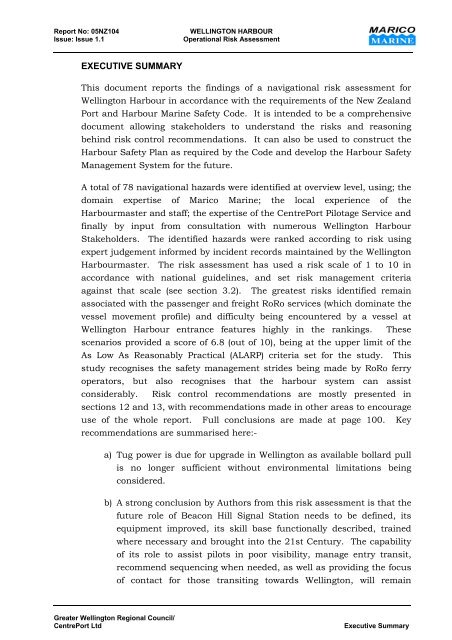MARICO Marine NZ Limited WELLINGTON HARBOUR PORT AND ...
MARICO Marine NZ Limited WELLINGTON HARBOUR PORT AND ...
MARICO Marine NZ Limited WELLINGTON HARBOUR PORT AND ...
Create successful ePaper yourself
Turn your PDF publications into a flip-book with our unique Google optimized e-Paper software.
Report No: 05<strong>NZ</strong>104 <strong>WELLINGTON</strong> <strong>HARBOUR</strong><br />
Issue: Issue 1.1 Operational Risk Assessment<br />
EXECUTIVE SUMMARY<br />
This document reports the findings of a navigational risk assessment for<br />
Wellington Harbour in accordance with the requirements of the New Zealand<br />
Port and Harbour <strong>Marine</strong> Safety Code. It is intended to be a comprehensive<br />
document allowing stakeholders to understand the risks and reasoning<br />
behind risk control recommendations. It can also be used to construct the<br />
Harbour Safety Plan as required by the Code and develop the Harbour Safety<br />
Management System for the future.<br />
A total of 78 navigational hazards were identified at overview level, using; the<br />
domain expertise of Marico <strong>Marine</strong>; the local experience of the<br />
Harbourmaster and staff; the expertise of the CentrePort Pilotage Service and<br />
finally by input from consultation with numerous Wellington Harbour<br />
Stakeholders. The identified hazards were ranked according to risk using<br />
expert judgement informed by incident records maintained by the Wellington<br />
Harbourmaster. The risk assessment has used a risk scale of 1 to 10 in<br />
accordance with national guidelines, and set risk management criteria<br />
against that scale (see section 3.2). The greatest risks identified remain<br />
associated with the passenger and freight RoRo services (which dominate the<br />
vessel movement profile) and difficulty being encountered by a vessel at<br />
Wellington Harbour entrance features highly in the rankings. These<br />
scenarios provided a score of 6.8 (out of 10), being at the upper limit of the<br />
As Low As Reasonably Practical (ALARP) criteria set for the study. This<br />
study recognises the safety management strides being made by RoRo ferry<br />
operators, but also recognises that the harbour system can assist<br />
considerably. Risk control recommendations are mostly presented in<br />
sections 12 and 13, with recommendations made in other areas to encourage<br />
use of the whole report. Full conclusions are made at page 100. Key<br />
recommendations are summarised here:-<br />
a) Tug power is due for upgrade in Wellington as available bollard pull<br />
is no longer sufficient without environmental limitations being<br />
considered.<br />
b) A strong conclusion by Authors from this risk assessment is that the<br />
future role of Beacon Hill Signal Station needs to be defined, its<br />
equipment improved, its skill base functionally described, trained<br />
where necessary and brought into the 21st Century. The capability<br />
of its role to assist pilots in poor visibility, manage entry transit,<br />
recommend sequencing when needed, as well as providing the focus<br />
of contact for those transiting towards Wellington, will remain<br />
Greater Wellington Regional Council/<br />
CentrePort Ltd Executive Summary
















